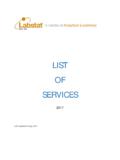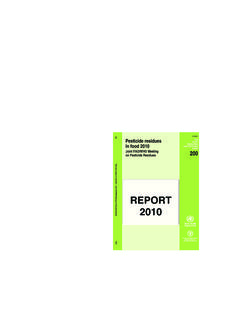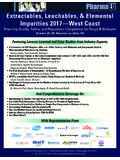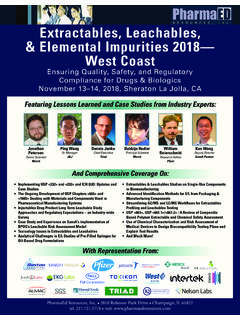Transcription of Pharmaceuticals in Drinking-water - WHO
1 Pharmaceuticals in Drinking-water Public Health and Environment water , Sanitation, Hygiene and Health WHO/HSE/ Pharmaceuticals in Drinking-water World Health Organization 2011 The illustration on the cover page is extracted from Rescue Mission: Planet Earth, Peace Child International 1994; used by permission. All rights reserved. Publications of the World Health Organization can be obtained from WHO Press, World Health Organization, 20 Avenue Appia, 1211 Geneva 27, Switzerland (tel.)
2 : +41 22 791 3264; fax: +41 22 791 4857; e-mail: Requests for permission to reproduce or translate WHO publications whether for sale or for non-commercial distribution should be addressed to WHO Press at the above address (fax: +41 22 791 4806; e-mail: The designations employed and the presentation of the material in this publication do not imply the expression of any opinion whatsoever on the part of the World Health Organization concerning the legal status of any country, territory, city or area or of its authorities, or concerning the delimitation of its frontiers or boundaries.)
3 Dotted lines on maps represent approximate border lines for which there may not yet be full agreement. The mention of specific companies or of certain manufacturers products does not imply that they are endorsed or recommended by the World Health Organization in preference to others of a similar nature that are not mentioned. Errors and omissions excepted, the names of proprietary products are distinguished by initial capital letters. All reasonable precautions have been taken by the World Health Organization to verify the information contained in this publication.
4 However, the published material is being distributed without warranty of any kind, either expressed or implied. The responsibility for the interpretation and use of the material lies with the reader. In no event shall the World Health Organization be liable for damages arising from its use. This publication contains the collective views of an international group of experts and does not necessarily represent the decisions or the policies of the World Health Organization. v Contents List of acronyms and vi Acknowledgements .. vii Executive summary.
5 Viii 1. Occurrence of Pharmaceuticals in water .. 1 Advances in analytical and detection 1 Occurrence of Pharmaceuticals in surface water .. 3 4 Occurrence of Pharmaceuticals in 5 Conclusion .. 6 2. Human health risk assessment for Pharmaceuticals in Drinking-water .. 7 Introduction .. 7 Assessing risks associated with Pharmaceuticals in Drinking-water .. 7 Applying the MTD approach: a drinking water Inspectorate 9 Applying the ADI approach .. 10 Awwa Research Foundation study ..10 Australian Guidelines for water Recycling ..13 Conclusion.
6 13 3. Treatment technologies for removal of Pharmaceuticals from water .. 15 Introduction .. 15 Removal of Pharmaceuticals by wastewater treatment processes .. 15 Removal of Pharmaceuticals by Drinking-water treatment 17 Conclusion .. 20 4. Preventing Pharmaceuticals in 22 Improved regulations and guidance on pharmaceutical waste management .. 22 pharmaceutical take-back 23 Raising consumer awareness .. 24 Conclusion .. 24 5. Conclusions, recommendations and knowledge 25 Conclusions .. 25 Recommendations .. 26 Knowledge gaps and future research.
7 26 28 vi List of acronyms and abbreviations ADI acceptable daily intake DWEL Drinking-water equivalent level EDC endocrine disrupting chemical FAO Food and Agriculture Organization of the United Nations GAC granular activated carbon GC gas chromatography LC liquid chromatography LOAEL lowest-observed-adverse-effect level LOQ limit of quantification MF microfiltration MOE margin of exposure MS mass spectrometry MS/MS tandem mass spectrometry MTD minimum therapeutic dose nd not detected NF nanofiltration NOAEL no-observed-adverse-effect level NSAID non-steroidal anti-inflammatory drug PAC powdered activated carbon PoD point of departure PUB Public Utilities Board (Singapore) RO reverse osmosis SF sand filtration TDI tolerable daily intake UF ultrafiltration USA United States of America USEPA United States Environmental Protection Agency UV ultraviolet WHO World Health Organization WSH water , Sanitation, Hygiene and Health unit (WHO) vii Acknowledgements The World Health Organization (WHO)
8 Wishes to express its appreciation to all those who contributed to the preparation and development of this document through the provision of their time, expertise and experience. WHO thanks the United States Environmental Protection Agency (USEPA) and Public Utilities Board (PUB) Singapore for their financial and technical support in developing this guidance to address an emerging issue for Drinking-water . WHO acknowledges the contributions of the members of the Working Group on Pharmaceuticals in Drinking-water , who provided important technical inputs for WHO s consideration in the development of this document.
9 The working group members are: - Dr Joe Cotruvo, Independent Consultant, Joseph Cotruvo and Associates, United States of America (USA) - Dr Mary Couper, formerly Quality Assurance and Safety: Medicines, WHO, Switzerland - Dr David Cunliffe, Department of Health, Environmental Health Service, Australia - Mr John Fawell, Independent Consultant, England - Ms Mich le Giddings, water , Air and Climate Change Bureau, Health Canada, Canada - Dr Edward Ohanian, USEPA, USA - Professor Choon Nam Ong, National University of Singapore, Singapore - Dr Hans Sanderson, Danish National Environmental Research Institute, Aarhus University, Denmark - Dr Dai Simizaki, National Institute of Public Health, Japan - Professor Giampaolo Velo.
10 University of Verona, Italy Special appreciation is extended to Mr John Fawell, independent consultant, England, who provided valuable time and technical expertise in the development of this document. Appreciation also goes to Dr Emma Goslan, Cranfield University, England, who contributed technical inputs to the chapter on the efficacy of removal of Pharmaceuticals during wastewater and Drinking-water treatment. The development and production of this document were coordinated and managed by staff of the water , Sanitation, Hygiene and Health (WSH) unit of WHO, including Mr Robert Bos (Coordinator, WSH), Mr Bruce Gordon and Mr Chee-Keong Chew (technical officers).














